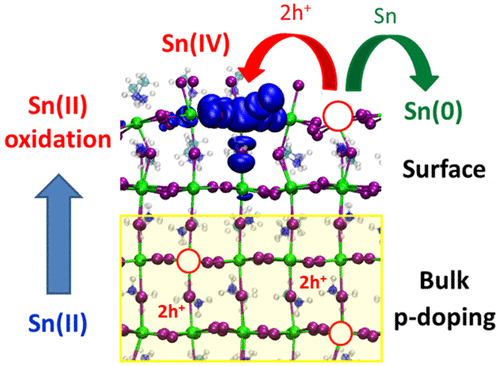当前位置:
X-MOL 学术
›
ACS Energy Lett.
›
论文详情
Our official English website, www.x-mol.net, welcomes your feedback! (Note: you will need to create a separate account there.)
Instability of Tin Iodide Perovskites: Bulk p-Doping versus Surface Tin Oxidation
ACS Energy Letters ( IF 22.0 ) Pub Date : 2020-07-27 , DOI: 10.1021/acsenergylett.0c01174 Damiano Ricciarelli 1, 2 , Daniele Meggiolaro 2 , Francesco Ambrosio 2, 3 , Filippo De Angelis 1, 2, 3, 4
ACS Energy Letters ( IF 22.0 ) Pub Date : 2020-07-27 , DOI: 10.1021/acsenergylett.0c01174 Damiano Ricciarelli 1, 2 , Daniele Meggiolaro 2 , Francesco Ambrosio 2, 3 , Filippo De Angelis 1, 2, 3, 4
Affiliation

|
Tin halide perovskites represent the only realistic route toward lead-free perovskite optoelectronics. Despite significant progress, however, the device efficiency and stability of solar cells are still limited by the perovskite self-p-doping and by Sn(II) oxidation to Sn(IV). By employing state-of-the-art density functional theory simulations, we unveil the mechanistic features and energetics of Sn(II) → Sn(IV) oxidation in pristine and defective models. Surprisingly, tin oxidation is predicted to be considerably unfavorable in bulk MASnI3 while it is energetically favored at unpassivated perovskite surfaces. As a consequence, bulk Sn(IV) spontaneously transforms into Sn(II), releasing two holes to the valence band and p-doping the perovskite, while surface Sn(IV) acts as a deep electron trap and contributes to nonradiative carrier recombination. The stoichiometry and the valence band surface pinning are found to largely influence the formation of Sn(IV), pointing to surface passivation as the main strategy to obtain efficient and stable tin halide solar cells.
中文翻译:

碘化锡钙钛矿的不稳定性:p型掺杂与表面锡氧化的关系
卤化锡钙钛矿是实现无铅钙钛矿光电的唯一现实途径。然而,尽管取得了重大进展,但是钙钛矿自p型掺杂和Sn(II)氧化成Sn(IV)仍然限制了太阳能电池的器件效率和稳定性。通过使用最新的密度泛函理论模拟,我们揭示了原始模型和缺陷模型中Sn(II)→Sn(IV)氧化的机理和能量。出乎意料的是,锡的氧化被预测在大量的MASnI 3中是非常不利的而在未经钝化的钙钛矿表面上则受到大力青睐。结果,大量的Sn(IV)自发转变为Sn(II),向价带释放两个空穴并p掺杂钙钛矿,而表面Sn(IV)充当深电子陷阱,并有助于非辐射载流子复合。发现化学计量和价带表面钉扎在很大程度上影响Sn(IV)的形成,指出表面钝化是获得有效和稳定的卤化锡太阳能电池的主要策略。
更新日期:2020-09-11
中文翻译:

碘化锡钙钛矿的不稳定性:p型掺杂与表面锡氧化的关系
卤化锡钙钛矿是实现无铅钙钛矿光电的唯一现实途径。然而,尽管取得了重大进展,但是钙钛矿自p型掺杂和Sn(II)氧化成Sn(IV)仍然限制了太阳能电池的器件效率和稳定性。通过使用最新的密度泛函理论模拟,我们揭示了原始模型和缺陷模型中Sn(II)→Sn(IV)氧化的机理和能量。出乎意料的是,锡的氧化被预测在大量的MASnI 3中是非常不利的而在未经钝化的钙钛矿表面上则受到大力青睐。结果,大量的Sn(IV)自发转变为Sn(II),向价带释放两个空穴并p掺杂钙钛矿,而表面Sn(IV)充当深电子陷阱,并有助于非辐射载流子复合。发现化学计量和价带表面钉扎在很大程度上影响Sn(IV)的形成,指出表面钝化是获得有效和稳定的卤化锡太阳能电池的主要策略。


























 京公网安备 11010802027423号
京公网安备 11010802027423号